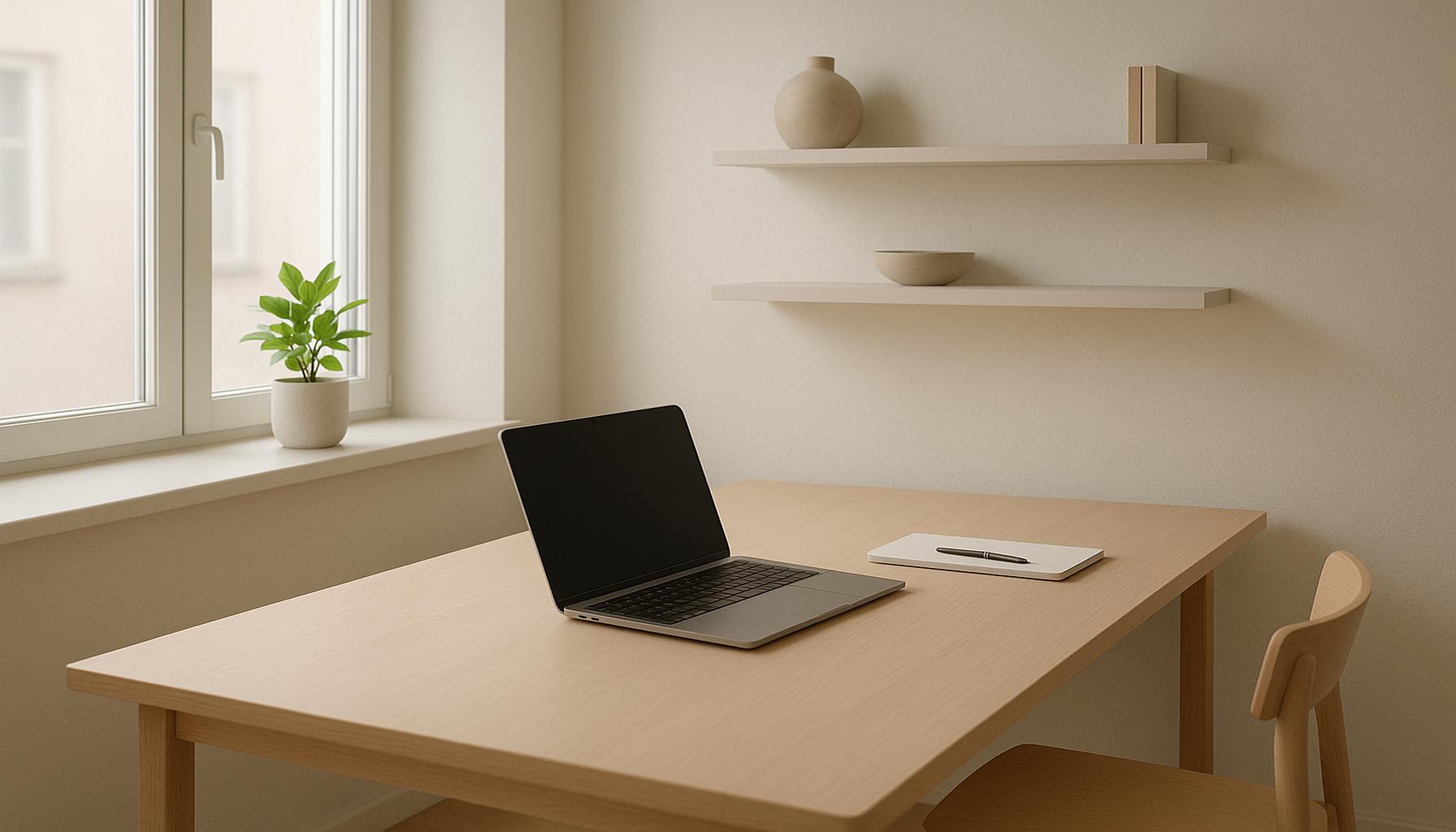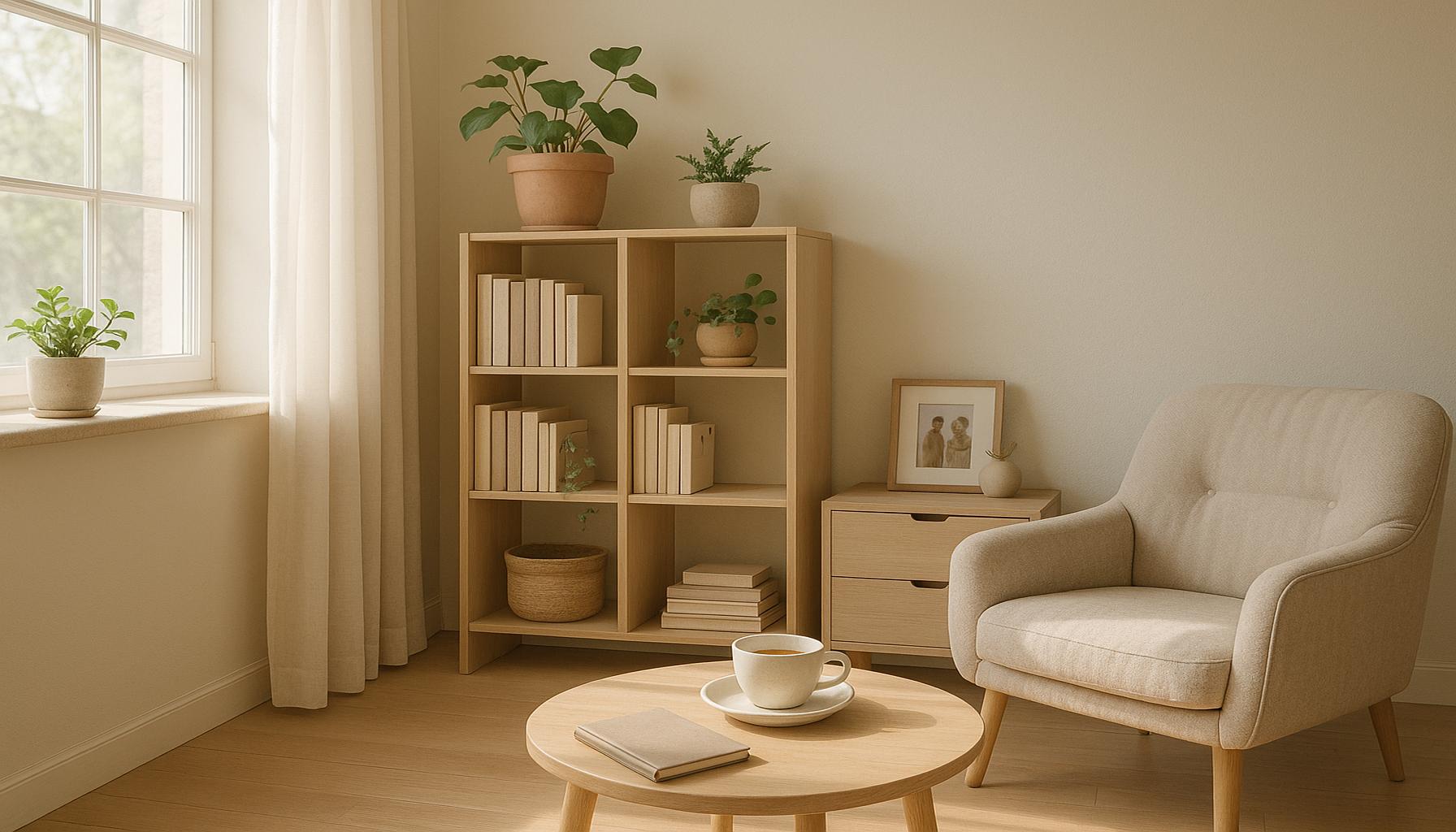Effective decluttering strategies to create a minimalist work environment

Creating Clarity Through Minimalism
In today’s fast-paced professional landscape, a cluttered workspace can lead to decreased productivity and heightened stress. Embracing a minimalist work environment can transform not only your physical space but also your mental clarity. By focusing on effective decluttering strategies, you can cultivate a workspace that fosters creativity and efficiency.
Consider the following effective strategies for decluttering:
- Assess Your Needs: Identify essential items that truly contribute to your work. Take inventory of your desk items, and ask yourself which tools you use daily versus those that gather dust. For instance, if you have notebooks that haven’t seen ink in months, it might be time to clear them out.
- Establish Zones: Designate specific areas for different tasks to minimize cross-clutter. You might create a dedicated zone for administrative work, another for creative brainstorming, and even a space for meetings. This helps streamline your workflow, allowing you to switch contexts without hesitation.
- Go Digital: Reduce paper by utilizing digital tools and cloud storage. Consider transitioning to apps that cover everything from note-taking to project management. Not only does this clear physical space but it also makes organization more fluid and accessible, allowing you to find documents at the click of a button.
- Regular Reviews: Schedule time weekly or monthly to evaluate what you truly need. Set aside 15 minutes each week to assess your workspace, removing items that no longer serve your goals. This roof maintenance tags along with the principles of minimalism, ensuring your space remains purpose-driven.
Statistics reveal that an uncluttered office can improve focus by nearly 30%. This data highlights the necessity of reconsidering what we keep in our work environments. Minimalism isn’t just about having fewer things; it’s about making space for what matters most—be it the tools that enhance your productivity or simply a clearer mental state.
Take, for instance, tech giants like Apple. Their clean and minimalist design philosophy is not merely an aesthetic choice but a deliberate strategy to reduce distractions and promote a focused work culture. Similarly, many successful startups in Silicon Valley have adopted open, uncluttered spaces to foster collaboration and innovation among their teams.
With the right approach, your work environment can reflect a sense of calm and order that enhances performance and satisfaction. Imagine walking into a workspace that invites creativity instead of overwhelming you. But it starts with a careful assessment of your needs and an intentional effort to create a more serene atmosphere.

Let’s dive deeper into how you can implement these effective decluttering strategies in your own workspace for a more productive future. Understanding the impact of each item and its function within your workspace can pave the way for a clearer, more focused mind, enabling you to tackle challenges more effectively.
DIVE DEEPER: Click here to discover the benefits of decluttering on your mental well-being
Decluttering Techniques to Foster Productivity
Creating a minimalist work environment is not merely about reducing the number of items on your desk; it is a conscious effort to streamline your productivity and mental state. To achieve an atmosphere that encourages creativity and focus, you can employ a variety of effective decluttering strategies. Here are several practical techniques to help you identify what to keep, what to remove, and how to maintain an organized workspace.
- Utilize the Four-Box Method: One popular decluttering technique involves using four boxes or bins to categorize items: Keep, Donate, Trash, and Relocate. As you go through your belongings, place items into the appropriate box. This visual cue not only makes decision-making simpler but also encourages a sense of accomplishment as you see tangible results.
- Adopt a “One In, One Out” Rule: To prevent future clutter from accumulating, practice the “One In, One Out” principle. For every new item you introduce to your workspace, commit to removing an existing one. This strategy helps maintain balance and enforces the mindset that your workspace should only contain what is necessary and useful.
- Optimize Storage Solutions: Invest in storage solutions that promote organization and accessibility. Consider utilizing drawer organizers, shelving units, or desktop trays that allow for easy categorization of essential items. Transparent containers can also help keep items visible while still containing clutter, ensuring your workspace remains tidy and functional.
- Limit Personal Items: While it is important to personalize your workspace, excessive decor can become a source of distraction. Keep personal items to a minimum, selecting only a few cherished items that inspire you. This ensures your workspace maintains a professional appearance while still reflecting your personality.
Implementing these effective decluttering strategies can set the stage for a more streamlined and inviting work environment. According to studies, a cleaner workspace can lead to a significant improvement in concentration levels—up to 25% in some cases. Such findings highlight the importance of creating a space that is conducive to focus and efficiency.
Furthermore, businesses have seen the positive impacts of minimalism firsthand. Many companies, particularly in the tech industry, have redesigned their offices with an emphasis on open spaces, showcasing the benefits of decluttering on collaboration and teamwork. Google’s headquarters, renowned for its flexible and open workspaces, serves as a prime example of how a minimalist design can encourage creativity while reducing stress.
By adopting these strategies and fostering a clear, organized atmosphere, you will be closely aligning your physical environment with your professional goals. A thoughtfully curated workspace not only enhances productivity but also acts as a foundation for a healthier work-life balance. As we continue exploring best practices for decluttering, it’s essential to recognize how simplicity can lead to powerful outcomes in your work environment.
Effective Decluttering Strategies for a Minimalist Work Environment
Creating a minimalist work environment can enhance productivity and foster creativity. It involves more than just reducing physical clutter; it requires a deep understanding of what is necessary for optimal functioning. Below, we’ll explore some effective decluttering strategies that can facilitate a workspace transformation.
| Strategy | Description |
|---|---|
| Regular Cleaning Schedule | Establishing a predetermined routine for cleaning can prevent accumulation of unwanted items. |
| Declutter by Category | Focus on one category at a time, such as paper or digital files, for an organized approach. |
| Function Over Form | Keep items that serve a purpose. Avoid keeping decorations that do not enhance work. |
| Digital Declutter | Organizing files and emails is vital; consider using apps to streamline this process. |
By implementing these strategic measures, individuals can not only achieve a minimalist work environment but also promote greater focus and efficiency. Each of these methods contributes uniquely to the overall goal of simplification. Remember, the key is consistency. When every item has a purpose and a place, the benefits extend beyond aesthetics, leading to enhanced mental clarity and productivity.
DISCOVER MORE: Click here to enhance your productivity
Tech-Driven Decluttering Approaches
In today’s digital age, technology plays a critical role in fostering a minimalist work environment. By leveraging various apps and tools, individuals can streamline not only their physical workspace but also their digital footprint, contributing to a more organized and less distracting atmosphere. Here are a few tech-driven strategies that can complement your decluttering efforts.
- Digital Minimalism: Evaluate the applications and software you regularly use. Get rid of any unnecessary apps that clutters your digital space. Aim to consolidate tasks into fewer platforms; for instance, instead of using multiple to-do list applications, consider a single comprehensive solution such as Todoist or Notion. This consolidation reduces distractions and simplifies task management.
- Cloud Storage Solutions: Transition essential documents and files to cloud-based storage, such as Google Drive or Dropbox. This not only frees up physical storage space but also ensures that your important files are accessible from any device. Regularly audit your cloud storage to eliminate outdated files, ensuring that your digital workspace remains just as decluttered as your physical one.
- Utilize Organizational Software: Programs that assist in project management—like Trello or Asana—can help maintain clarity not only in task assignments but also in timelines and priorities. Visualization of workflows helps reduce mental clutter, allowing you to focus on what really matters. Furthermore, the use of a shared platform can aid in team collaboration and communication, reducing the reliance on countless emails and meetings.
- Leverage Automation: Embrace automation tools like IFTTT or Zapier. These help streamline repetitive tasks, such as data entry or social media posting. Creating automated workflows not only saves time but also minimizes the mental load associated with managing various tasks, allowing you to concentrate on more critical projects.
Implementing these tech-driven decluttering approaches can have a profound impact on your work efficiency and overall mental well-being. According to a report by the American Psychological Association, individuals with organized digital and physical spaces report lower stress levels and higher job satisfaction. When everything is in its place—both online and offline—you create a sense of control that can lead to greater motivation and productivity.
Additionally, consider the impact of reducing digital distractions. Numerous studies indicate that excessive screen time and notifications can detract from focus and increase anxiety. Setting strict boundaries on your digital interaction—like using “Do Not Disturb” features during work hours—can be crucial. This practice fosters deeper concentration and enhances your ability to produce high-quality work.
Also, in light of the rise of remote work, organizations are increasingly recognizing the importance of a decluttered digital workspace. Companies often provide resources on digital organization to equip employees with the necessary skills to maintain productivity in remote settings. Workshops on digital minimalism may become standard offerings, further demonstrating the commitment toward a minimalist approach in work cultures.
As you explore these options, keep in mind that minimalism is highly individualistic. What works for one person may not work for another. It’s essential to discover a decluttering approach that resonates with you and aligns with your work style. By embracing these tech-driven strategies, you not only contribute to a more streamlined workspace but also enhance your ability to navigate the complexities of the modern work environment more effectively.
DISCOVER MORE: Click here to learn how to declutter and enhance your productivity
Conclusion
As we navigate the demands of today’s fast-paced work environment, adopting effective decluttering strategies becomes essential for fostering a minimalist workspace that enhances productivity and creativity. To summarize, both physical and digital decluttering hold significance; creating a cohesive system that prioritizes organization is paramount. Simplifying your surroundings by removing unnecessary items not only clears the clutter but also helps cultivate a sense of focus and calm.
Incorporating tech-driven approaches, such as digital minimalism, cloud storage solutions, and automation, can further streamline your workflows, empowering you to concentrate on essential tasks. Research indicates that individuals who maintain organized environments report lower stress levels and improved job satisfaction. As organizations recognize the advantages of a decluttered workspace, they are increasingly investing in resources that promote these practices among employees, especially in remote settings.
Ultimately, the journey to minimalism is a personal one. Finding a customized approach that aligns with your work habits is crucial. By experimenting with various decluttering strategies, you can determine what resonates with you and contributes to your unique productivity style. Embracing minimalism is not just about removing physical items; it’s about creating a balanced approach to work that promotes mental clarity and fosters sustainable practices in the long run. As you embark on this decluttering adventure, remember that the rewards extend beyond aesthetics— they provide you with the focus and tranquility needed to excel in your professional endeavors.


